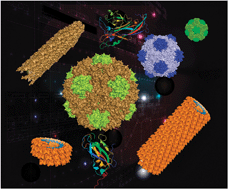Viruses belong to a fascinating class of natural supramolecular structures, composed of multiple copies of coat proteins (CPs) that assemble into different shapes with a variety of sizes from tens to hundreds of nanometres. Because of their advantages including simple/economic production, well-defined structural features, unique shapes and sizes, genetic programmability and robust chemistries, recently viruses and virus-like nanoparticles (VLPs) have been used widely in biomedical applications and materials synthesis. In this critical review, we highlight recent advances in the use of virus coat proteins (VCPs) and viral nanoparticles (VNPs) as building blocks in self-assembly studies and materials development. We first discuss the self-assembly of VCPs into VLPs, which can efficiently incorporate a variety of different materials as cores inside the viral protein shells. Then, the self-assembly of VNPs at surfaces or interfaces is summarized. Finally, we discuss the co-assembly of VNPs with different functional materials (178 references).

You have access to this article
 Please wait while we load your content...
Something went wrong. Try again?
Please wait while we load your content...
Something went wrong. Try again?


 Please wait while we load your content...
Please wait while we load your content...